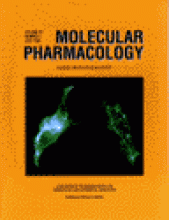Abstract
Overexpression of the human multidrug-resistance protein (MRP) causes a form of multidrug resistance similar to that conferred by P-glycoprotein, although the two proteins are only distantly related. In contrast to P-glycoprotein, human MRP has also been shown to be a primary active transporter of a structurally diverse range of organic anionic conjugates, some of which may be physiological substrates. At present, the mechanism by which MRP transports these compounds and mediates multidrug resistance is not understood. With the objective of developing an animal model for studies on the normal functions of MRP and its ability to confer multidrug resistance in vivo, we recently cloned the murine ortholog of MRP (mrp). To assess the degree of functional conservation between mrp and MRP, we directly compared the drug cross-resistance profiles they confer when transfected into human embryonic kidney cells, as well as their ability to actively transport leukotriene C4, 17β-Estradiol 17β-(d-glucuronide), and vincristine; mrp and MRP conferred similar drug resistance profiles, with the exception that only MRP conferred resistance to the anthracyclines tested. Consistent with these findings, accumulation of [3H]vincristine and [3H]VP-16 was decreased, and efflux of [3H]vincristine was increased in both murine and human MRP-transfected cell populations, whereas only human MRP-transfected cells displayed decreased accumulation and increased efflux of [3H]daunorubicin. Membrane vesicles derived from both transfected cell populations transported leukotriene C4 in an ATP-dependent manner with comparable efficiency, although the efficiency of 17β-estradiol 17β-(d-glucuronide) transport was somewhat higher with MRP transfectants. ATP-dependent transport of vincristine was also observed with vesicles from mrp and MRP transfectants but only in the presence of glutathione. These studies reveal intrinsic differences between the murine and human MRP orthologs with respect to their ability to confer resistance to a major class of chemotherapeutic drugs.
Footnotes
- Received February 27, 1997.
- Accepted May 13, 1997.
-
Send reprint requests to: Roger G. Deeley, Ph.D., Cancer Research Laboratories, Botterell Hall, Queen’s University, Kingston, Ontario, Canada K7L 3N6. E-mail:deeleyr{at}post.queensu.ca
-
This work was supported by Grant 4570 from the National Cancer Institute of Canada with funds from the Canadian Cancer Society, Grant MT-10519 from the Medical Research Council of Canada, and the Ontario Cancer Treatment and Research Foundation. B.D.S. is supported by an Ontario Graduate Scholarship and in part by a Queen’s University Graduate Award. D.R.H. is supported by a studentship from the Medical Research Council of Canada. S.P.C.C. is a Senior Scientist of the Ontario Cancer Foundation. R.G.D. is the Stauffer Research Professor of Queen’s University.
- The American Society for Pharmacology and Experimental Therapeutics
MolPharm articles become freely available 12 months after publication, and remain freely available for 5 years.Non-open access articles that fall outside this five year window are available only to institutional subscribers and current ASPET members, or through the article purchase feature at the bottom of the page.
|






